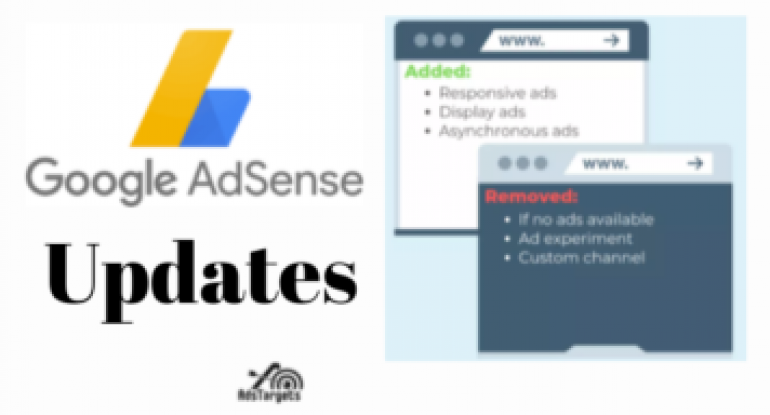Updated 22/04/2025
It is an easy guess that you are here to learn everything Google AdSense Ad Units Updates. Google Adsense has finally announced some of the changes most publishers saw since April 2019 in their Ad units. In an email sent recently, They officially confirm the Google AdSense ad unit updates.
The reason for the recent updates to Adsense ad units is to provide publishers with a more flexible, up-to-date service and a more secure platform.
Aside from that, they encourage publishers to always investigate the changes that may be implemented in their monetization of the advertising products.
So what are the updates in Google Adsense Ad units and what do publishers need to know about these updates?
There are several changes made in their Ad sizes, Ad Types, Text Ad styles, if no ads are available, experiments, Synchronous code and Custom channels.
Table of Contents
ToggleLet’s Look at These Changes and What Publishers Need to know
#1. Adsense Ad sizes updates
Google Adsense has made it easier for publishers to create and easily manage their ad sizes across all devices without further customization. This means all ad sizes are now responsive by default.

It is now possible for your ads to automatically adjust to fit different screen sizes both on desktop and mobile devices.
Usually, publishers had to create different ad units such as responsive ads, mobile ads, desktop, and placements.
It was just stressful creating and managing all these ad units. Now with the new updates, publishers don’t have to worry about all the hassle of creating and managing different ad sizes for increased flexibility and performance.
What publishers need to know
Even with these changes, publishers still have the option to create and manage different ad sizes if they want to.
You may also like: Google Ad Manager: Complete guide for publishers
#2. Display and Text Ad styles merged.
Google Adsense has now merged ‘Text ads only’ and ‘Display ads only’ to look more attractive as only display ads. Even though this is not a new ad type of Ad, it’s certainly new here for Adsense.

It’s all about giving a rich-media look to Google Ads just like other ad networks have been using Rich-media ad formats to increase CTR.
Publishers who are still willing to display the ‘Text ads only’ or ‘Display ads only’ format can go for native in-feed units and choose the manual style option to continue to create those separate ad units.

Ad units in your Adsense account have been renamed to “Display Ads” which will be updated to serve all Ad types.
What publishers need to know
Since Google AdSense now join many other ad networks that are already offering these types of ad format, there will be a bit of competition for publishers’ ad inventory ad these ads have a rich-media look.
#3. If No Ads Available is Gone
In the past, Adsence publishers were given the option to show blank colored blocks if there were no ads to show. That option is now removed.
Now Google Adsense defaults it to collapsing the ad space or showing a blank space. In case you have your current setting as a color or another URL, it will be updated in the near future.
The reason for this change is to increase the quality and safety of their Ad Network while reducing the number of malicious ads in Adsense, Google has removed the “If no ads available” option.
What publishers need to know
Publishers will now use those blank ad spaces as part of their websites or blog designs which will preserve the original look of your web pages. It will also give publishers the opportunity to improve their fill rates.
#4. The Experiment Ad Unit is also Removed
As a result of the above changes, the Ad unit experiment option has also been removed. Publishers need to know that if you have ad unit experiments going on, they won’t continue.

However, publishers that had their data and experiments previously will still remain in place but won’t be able to run new experiments.
What publishers need to know
Publishers will now find it difficult to run tests on various ad units to determine the best performing ad units in order to make choices.
Note, experiment by changing the ad serving settings or the ad category and ‘Ad balance’ to determine the right balance between ads and revenue are still available for publishers.
#5. Synchronous code is also removed
Usually, this feature was not used by the majority of publishers as it was labeled “Not recommended” by Google ad sense. Is as good as removing a redundant feature.

Synchronous code is not recommended because it increases the page load time which slows down the load speed of web pages.
Now that it’s removed, publishers won’t have the option to create synchronous codes but still have the option to create them manually generate synchronous ad code for your ad units.
What publishers need to know
For the majority of publishers, this should not border them as it won’t have any major impact on their ad publishing and revenue.
#6. The Custom Channels Feature is also Disabled
According to Adsense, “Advertisers no longer buy placement targeted ads, so custom channels are only used for reporting now.” Publishers will still be able to create and view their “custom channels” reports.
Google states that “In the future, you’ll need to add the custom channel ID to your ad unit code to track the performance of ad units in this way”.
Alternatively, publishers will be able to see the performance of their ad units by running the “Ad units” report and using the filters to limit the data to those ad units.
What publishers need to know
The lesson here is to understand that, the reporting system has changed for publishers. In order the get the report and the data they need, publishers will need to customize the report by using ad units or Ad ID to track their performance.
Conclusions
These changes in Google Adsense have a lot of positive impacts on publishers with little to zero negative impacts. Mostly, they are designed to provide a more flexible and secure publishing experience for publishers
Making all Ads responsive will definitely increase publishers’ performance while merging display and text ads units will make ads more attractive all for the benefit of publishers.
Features such as experiments are now gone, and publishers will no longer be able to track their performance in the traditional way. This should not be a problem as there are other options such as customizing those ads using Ad units and Ad ID to track their performance.
Overall, Google Adsense Ad Units updates are for good and for the benefit of publishers.









2 Responses
Which ad unit is best for all article website?
It depends on your website content. First, I advise you to experiment and see what work best for your site.